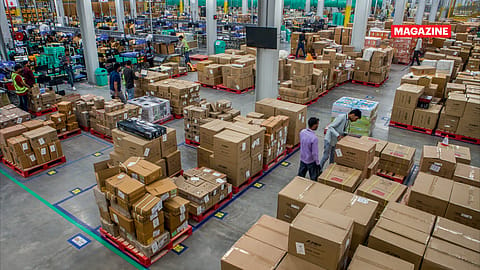Samir Kumar’s big task for Amazon India: Make the e-commerce giant truly ‘the everything store’
Country manager Samir Kumar wants Amazon India to bridge product gaps to live up to its tag of ‘the everything store’

This story belongs to the Fortune India Magazine June 2025 issue.
Samir Kumar doesn’t mince words. “Look around this room. That nail on the wall, that cable on the floor, the faucet leaking in your bathroom… I’m not sure we sell the right version of any of those yet,” the Amazon India country manager tells Fortune India.
The candid admission by the head of the online retailer—famously dubbed ‘the everything store’—may sound surprising. But in India, ‘the everything store’ is still a work in progress for Amazon.
Few people know Amazon India as well as Kumar does. Having joined the company as a systems engineer in 1999, he helped Amit Agarwal (now senior vice president for emerging markets) set up the company’s development centre in India in 2004. He returned in 2012 to lay the groundwork for the launch of Amazon.in. He terms these formative years as the most rewarding in his career.
Now, at the helm of Amazon India, Kumar, a company veteran, has a far more complex mandate: to live up to the promise of ‘the everything store’.
He is pushing for an aggressive expansion, not only in speed through the quick commerce pilots, but also in selection. Amazon India reveals a strategic gap less obvious to most of its customers in the selection frontier. For all its vastness, the platform still doesn’t have a comprehensive assortment of the real-world goods Indian consumers increasingly demand.
The selection imperative
At the heart of Amazon’s global growth model is its “flywheel” strategy: expand product picks, improve customer experience, attract more sellers, build scale, reduce costs, and reinvest in selection. It is a virtuous cycle built on breadth and depth.
More Stories from this Issue
In the US, this flywheel has achieved near-legendary status. You can buy a rare plumbing valve or a discontinued auto part in a few clicks. In India, that’s far from reality.
“Do we sell all the SKUs for a faucet? Probably not,” Kumar concedes. “We’ve made great progress in fashion, electronics, and grocery, but we’re nowhere close to Amazon.com’s level of assortment, especially in long-tail, utilitarian categories such as auto spares, office furniture, or DIY home improvement,” says Kumar, a DIY enthusiast himself.
The challenge isn’t demand. India is home to over 300 million vehicles, a booming home construction and renovation market, and millions of small offices in need of functional furniture and supplies. But serving this fragmented, highly regionalised, often low-value demand at scale is a tall order, even for Amazon.
So, what makes these categories so hard to crack for Amazon?
(INR CR)
For one, supplier fragmentation. Unlike phones or fashion, where a few large brands dominate, segments like plumbing or car parts are teeming with hyperlocal manufacturers and unorganised distributors. Building reliable sourcing pipelines in such categories requires painstaking onboarding, standardisation, and cataloguing work.
Second, logistics complexity. A smartphone is compact and easy to warehouse; a refrigerator or plumbing fitting isn’t. The real challenge, Kumar explains, is figuring out how to move selection closer to the customer—by improving infrastructure, enabling sellers to register across states, and setting up fulfilment in every region. “It’s not just one thing,” he says. “There’s plenty we need to get right to serve every pin code with the right product at the right time.”
Building the next boAt
For Kumar, however, the solution isn’t just about filling digital shelves—it’s about empowering sellers. “We’re now using Generative AI to auto-create product listings, clean up catalogue defects, and help sellers onboard with just a photo and voice description,” he says.
The goal—reduce the friction in onboarding India’s massive base of small and midsize manufacturers who have never sold online before.
Amazon has also rolled out a zero-fee policy for low-value items, nudging more sellers to list the kind of low-ticket SKUs—like single faucet washers or cable ties—that define offline general trade.
But it’s not just about reactive fixes. Kumar believes Amazon India must become a cradle for new brands—the next boAt (the home-grown audio brand) or Mamaearth (the personal care brand)—and take them global.
“That’s how we close the selection gap,” he says. “We don’t just chase existing inventory. We help create the next generation of Indian brands across categories, and we help them scale.”
The institutional opportunity
One of the lesser talked about areas Kumar is bullish on is institutional and B2B demand. “Every office needs supplies, including laptops. Can Amazon become their default procurement platform?” he asks as he highlights the massive and underserved opportunity.
This B2B expansion could help Amazon solve its unit economics puzzle. Bulk buyers offer scale, recurring orders, and more predictable logistics, making it easier to stock long-tail categories that otherwise have low volume but high complexity.
For instance, Amazon India still doesn’t sell every laptop brand. Kumar notes that not all sellers have relationships with the major or emerging players in the segment yet. While the platform has helped incubate several new brands, he believes there’s still a long way to go.
The e-commerce giant now delivers to all serviceable pin codes with fulfilment centres across 15 states, 43 million cubic ft of storage space, and more than 1.2 million sellers. Yet, the task ahead isn’t only adding products—it is about re-architecting supply chains, democratising seller access, and rethinking how Indians browse, buy, and build businesses online.
“If it was easy, why would I be involved?” Kumar jokes. “Give us the toughest problem, we’ll solve it.” The remark testifies to Kumar’s efforts in giving Amazon its identity in India—‘the everything store’.